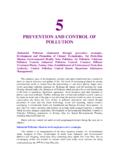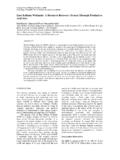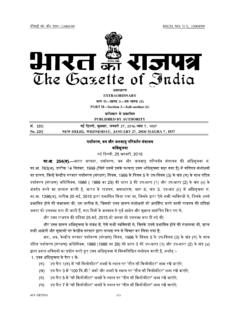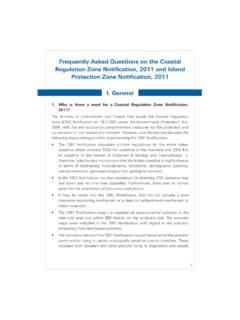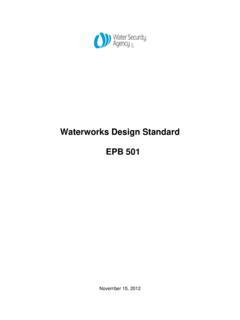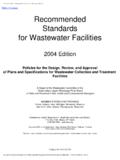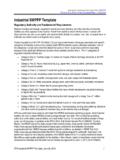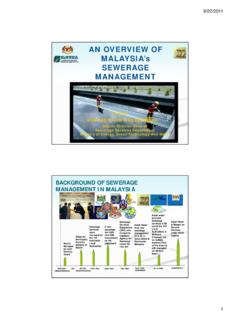Transcription of GUIDELINES FOR RECOGNITION OF …
1 1 LABORATORY ANALYTICAL TECHNIQUES SERIES LATS/9/ 2008 -2009 (Revised & Updated Version) GUIDELINES FOR RECOGNITION OF ENVIRONMENTAL LABORATORIES UNDER THE ENVIRONMENT (PROTECTION) ACT, 1986 CENTRAL POLLUTION CONTROL BOARD MINISTRY OF ENVIRONMENT & FORESTS `Parivesh Bhawan , East Arjun Nagar Delhi -110 032 E-mail: Website: MoEF Website: June, 2008 2 3 4 CONTENTS Page No. INTRODUCTION 01 Environmental Laboratory 01 Legal Provisions of RECOGNITION of Environmental Laboratories 01 The Water (Prevention & Control of Pollution) Act, 1974 02 The Air (Prevention & Control of Pollution) Act, 1981 02 The Environment (Protection) Act, 1986 03 ENVIRONMENTAL LABORATORIES INFRASTRUCTURAL REQUIREMENTS 03 Laboratory Design/Housing/Building 03 Laboratory Furniture 04 Electricity supply and Electrical services 05 Laboratory Instruments/Equipment 06 Sample Digestion System/Hood system 09 Water Supply and Distilled / De-ionized water 09 Glassware/Polytheneware/other Labwares 10 Quality of chemicals 10 Laboratory Work Environment 11 Safe Laboratory Practices 11 Environmental Laboratory Soundness 12 ENVIRONMENTAL SAMPLE HANDLING 13 Sample Tracking 13 Sample Acceptance Pre-requisite 13 Sample Receipt Protocol 14 Legal Samples 15 Sample Storage Conditions 16 Unused Sample Disposal 18 ACCREDITATION OF
2 ENVIRONMENTAL LABORATORIES 19 Accreditation Bodies/Standards for Laboratory Accreditation 19 Benefits of Accreditation 20 5 QUALITY ASSURANCE AND QUALITY CONTROL IN ENVIRONMENTAL LABORATORIES Quality Assurance Plan 21 Quality Control 23 Use of Reference Material (RM)/Certified Reference Material (CRM) 23 Analytical Quality Control (AQC) 24 Inter-laboratory Proficiency Testing Programme by Central Pollution Control Board 30 GUIDELINES FOR RECOGNITION OF LABORATORY UNDER THE ENVIRONMENT (PROTECTION) ACT, 1986 33 Annexure-I Proforma (Revised) for RECOGNITION of laboratories under Environment (Protection) Act, 1986 47 Annexure-II Inspection Report for evaluation of Environmental Laboratory(s) to be recognized under Environment (Protection) Act, 1986 76 Annexure-III Terms & conditions for RECOGNITION of laboratories under E(P) Act, 1986 87 Annexure-IV Terms & conditions for RECOGNITION of Govt.
3 Analyst under E(P) Act, 1986. 91 Annexure-V Bio-data Proforma for consideration of RECOGNITION as Govt. Analyst 94 Annexure-VI Blank Gazette Notification 96 ADDENDUM 98 6 INTRODUCTION Pollution is an undesirable change in physical, chemical or biological characteristics of our air, water or land that may or will harmfully affect human life, flora, fauna and materials . In our environment inter relationship exists between water, air, land and human beings, other living creatures, plants, micro-organism and property. This inter-relationship is disturbed due to undesirable alteration in abiotic component because of addition of solid, liquid or gaseous substances.
4 Any solid, liquid or gaseous substances present in such concentration as may be, or a tend to be injurious to environment is know as environmental pollutant and their presence indicate the environmental pollution . With the advancement of science and technology and rapid industrialization and urbanization, the environmental management becomes a major concern for our country. The need for maintenance of ecological balance and environmental protection has increased more than ever before. For successful implementation of environmental protection programme, it is essential to identify and quantify the pollution sources, pollutants, conduct baseline survey, lay down standards and build-up monitoring systems.
5 To meet out these requirements, a competent laboratory is required with all necessary instruments, equipment, expertise, capabilities etc. Environmental Laboratory The environmental laboratory plays a very important role in assessing the status of environment comprising both abiotic (soil, water and air) and biotic (flora, fauna and human being) components. An environmental laboratory is a laboratory processing samples taken from the environmental media (air, water, soil, biota) both from the environment as well as from sources disposing into the environment (industries, domestic and agriculture sources, automobiles etc.). The laboratories are the essential corner stones of any effective pollution control programme.
6 The analytical laboratories provide qualitative as well as quantitative data for good decision making purpose. For generating this valuable data with a desired accuracy and to quantify concentration of the constituents present in the samples, the laboratory should have the desired facilities and capabilities to achieve the above goal. Legal Provisions of RECOGNITION of Environmental Laboratories The need for laboratories in implementation of the various pollution control acts laid down for the protection of the environment is essential under the following sections of various acts. 7 The Water (Prevention and Control of Pollution), Act, 1974 Under Section 17 (2) Under Section 17(2), the Board (State) may establish or recognize a laboratory or laboratories to enable the Board to perform its functions under this Section efficiently, including the analysis of samples of water from any stream or well or of samples of sewage or trade effluents.
7 Under Section 25 & 26 Any person desirous of discharging any effluent (domestic or industrial) into a stream or well has to obtain the consent of the pollution control board before discharging the same. The consent application is supported by an analysis report obtained from a recognized laboratory of the Board. Under Section 51 & 52 Central/State Government has to establish a Central/State Water Laboratory and under section 53 subsection (i) and (ii), a government analyst (Central/State) is appointed to analyse the samples. Under Section 53 Subsection (iii) The Central/State Board is required to appoint a Board Analyst(s) to any laboratory established or recognized under section 16 or 17 of the Water Act, 1974.
8 The analysis report signed by a Government/Board Analyst is used as an evidence for the legal matters. The Air (Prevention and Control of Pollution) Act, 1981 Under Section 17 (2) Under Section 17(2) of The Air (Prevention & Control of Pollution) Act, 1981, a State Board may establish or recognize a laboratory or laboratories to enable the Board to perform its functions under this Section efficiently. Under Section 21 No person can operate any industrial plant in an air pollution control area without the previous consent of the Board. The analysis report obtained by the recognized laboratory in respect of the quantity of emissions is to be enclosed with the consent application. Under Section 28 & 29 Subsection (i) State Government should establish or specify one or more State Air Laboratories for the analysis of the samples of air.
9 Also under Section 29 sub-section (1), the State Govt. shall appoint the Government Analyst for the purpose of analyzing the samples received by the Government Laboratory under Section 28. 8 Under Section 29 Sub-section (ii) The State Government is required to appoint the Board Analyst(s) for analysis of the air samples under section 17. The Environment (Protection) Act, 1986 Under Section 12 The Central Govt. shall establish or recognize one or more environmental laboratories to carry out the functions entrusted to an environmental laboratory under the said Act. Under Section 13 Under this Section, Central Govt. shall appoint the Government Analyst(s) for carrying-out the analysis of samples of air, water, soil or these substance sent for analysis to the environmental laboratory established under section 12 of the Act.
10 ENVIRONMENTAL LABORATORIES INFRASTRUCTURAL REQUIREMENTS The laboratory should have sufficient space, proper design, interior furnishing, proper ventilation, proper lighting, temperature control, dust free atmosphere etc. since all these factors influence the quality of analytical data generated in a laboratory and also may affect the production of reliable data. Regular and proper supply of some of the essential needs like water and electricity is to be ensured for smooth functioning of the laboratory. In addition to these, other important factors like facilities for preservation of samples, weighing, cleaning of glassware, quality of chemicals, fire-fighting facilities, laboratory safety and first-aid facilities are also an essential requirements.

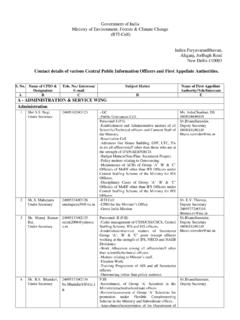
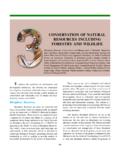
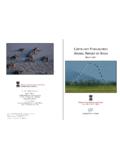

![Untitled-1 [www.moef.nic.in]](/cache/preview/0/7/5/4/5/e/c/5/thumb-07545ec5a24fcdf0c4f7836434cadcc8.jpg)
